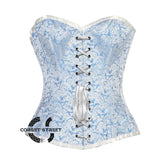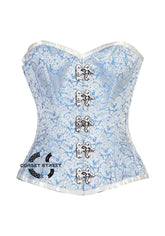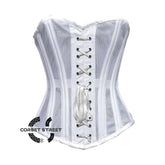Corsets Through Time: A Colorado Day Fashion Journey
In the heart of the American West, where the Rocky Mountains touch the sky and the spirit of adventure thrives, Colorado might not be the first place that comes to mind when you think of the intricate history of corsetry. Yet, like a delicate thread woven through centuries of fashion, corsets have left their indelible mark everywhere, evolving from instruments of rigid social conformity to statements of empowered self-expression. Join us on a "Colorado Day Fashion Journey" as we unravel the fascinating story of corsets through time.
The Dawn of Structure: From Stays to Victorian Ideals
Long before Colorado was even a territory, the ancestors of the modern corset, often called "stays," were already shaping European silhouettes. In the 16th century, these foundational garments, sometimes made with whalebone or reeds, aimed to flatten the torso and create a conical shape. Imagine the early pioneers, some perhaps arriving in what would become Colorado, bringing with them echoes of these European fashion sensibilities, even if their daily wear was far more practical.
The Victorian era, however, is arguably the golden age of corsetry. As Colorado boomed with the Gold Rush and silver mining, women across the world, including those arriving in the burgeoning cities of Denver and Leadville, embraced the highly cinched waist. The ideal "hourglass" figure, achieved through tightly laced corsets, became a symbol of femininity, respectability, and social status. Photographs from the late 19th century Colorado often depict women in elaborate gowns, their tiny waists testament to the prevailing fashion. While the practicalities of frontier life might have necessitated simpler attire for some, the desire for fashionable silhouettes remained.
The Turn of the Century and the Great War: A Loosening Grip
As the 20th century dawned, a new silhouette emerged. The "S-bend" corset, designed to push the bust forward and the hips back, was briefly popular, but the winds of change were blowing. The Belle Époque gave way to the roaring twenties, and with it, a radical shift in fashion. The flapper era championed a more boyish, uncorseted figure. The practicality demanded by World War I, and the increasing involvement of women in the workforce, further accelerated the decline of the heavily restrictive corset. Imagine the Colorado women, once confined, now embracing freedom of movement, perhaps riding horses or engaging in new professional roles with an ease unimaginable to their grandmothers.
Mid-Century and the Resurgence of Shapewear
While the rigid corsets of yore largely vanished, the desire for a sculpted silhouette never truly disappeared. The mid-20th century saw the rise of girdles and shapewear – lighter, more flexible garments designed to smooth and subtly shape the figure rather than drastically alter it. Think of the glamorous Hollywood stars of the era, and how their seemingly effortless curves were often aided by clever undergarments. In Colorado, as elsewhere, women continued to appreciate the confidence that a little foundational support could provide, even if it was a far cry from the whalebone of the past.
The Modern Era: Corsets as Art, Empowerment, and Expression
Today, the corset has undergone a remarkable transformation. No longer solely a symbol of societal constraint, it has re-emerged as a versatile fashion statement, a piece of art, and even a tool for empowerment. From high fashion runways to the vibrant streets of Denver's Capitol Hill, corsets are embraced by individuals who appreciate their unique aesthetic and their ability to create a striking silhouette.
Modern corsets come in a dazzling array of styles, fabrics, and designs. You'll find them worn as outerwear, paired with jeans for a chic, edgy look, or incorporated into elaborate cosplay and theatrical costumes. They are celebrated by the body positivity movement for their ability to enhance and celebrate individual shapes, rather than conforming to a narrow ideal.
In Colorado, where the spirit of individuality and self-expression is deeply ingrained, this modern reinterpretation of the corset resonates strongly. From historical reenactments at living history museums to steampunk conventions in Colorado Springs, or simply as a bold fashion choice for a night out in Boulder, the corset has found new life. It’s a testament to its enduring appeal, its adaptability, and its capacity to transcend its historical origins.
Our Colorado day fashion journey through time reveals that the corset, in its many forms, is more than just a garment. It's a mirror reflecting societal norms, evolving ideals of beauty, and the ongoing dance between restriction and liberation in fashion. And as we look to the future, it's clear that this remarkable piece of clothing will continue to shape, inspire, and intrigue for generations to come, even under the vast, open skies of Colorado.








